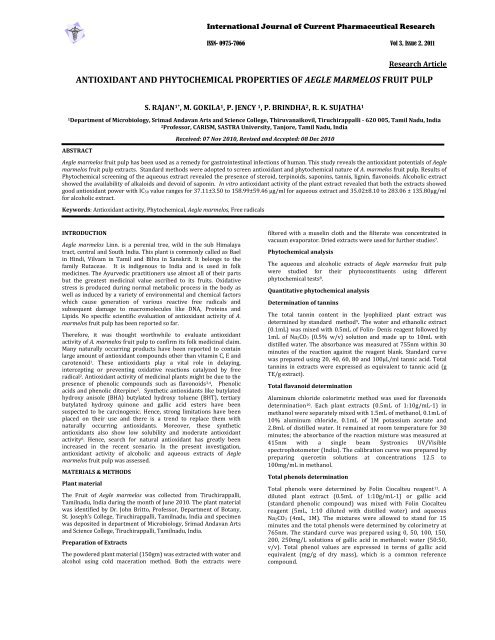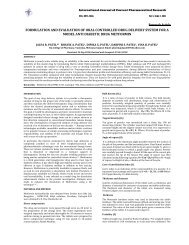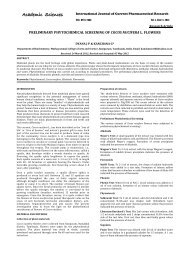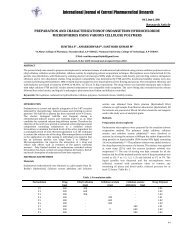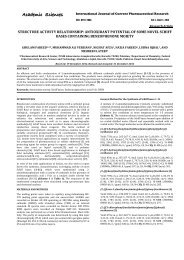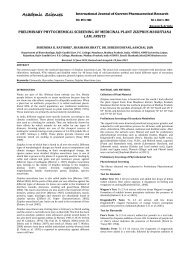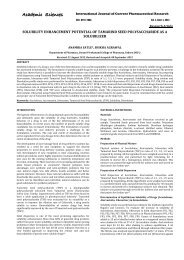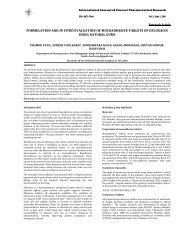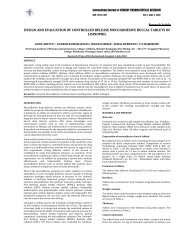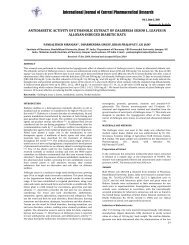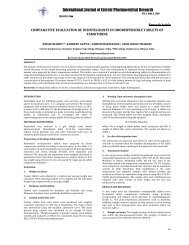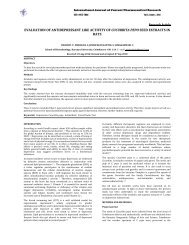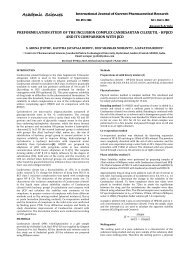antioxidant and phytochemical properties of aegle marmelos fruit pulp
antioxidant and phytochemical properties of aegle marmelos fruit pulp
antioxidant and phytochemical properties of aegle marmelos fruit pulp
- No tags were found...
Create successful ePaper yourself
Turn your PDF publications into a flip-book with our unique Google optimized e-Paper software.
International Journal <strong>of</strong> Current Pharmaceutical ResearchISSN- 0975-7066 Vol 3, Issue 2, 2011Research ArticleANTIOXIDANT AND PHYTOCHEMICAL PROPERTIES OF AEGLE MARMELOS FRUIT PULPS. RAJAN 1* , M. GOKILA 1 , P. JENCY 1 , P. BRINDHA 2 , R. K. SUJATHA 11Department <strong>of</strong> Microbiology, Srimad Andavan Arts <strong>and</strong> Science College, Thiruvanaikovil, Tiruchirappalli 620 005, Tamil Nadu, India2Pr<strong>of</strong>essor, CARISM, SASTRA University, Tanjore, Tamil Nadu, IndiaReceived: 07 Nov 2010, Revised <strong>and</strong> Accepted: 08 Dec 2010ABSTRACTAegle <strong>marmelos</strong> <strong>fruit</strong> <strong>pulp</strong> has been used as a remedy for gastrointestinal infections <strong>of</strong> human. This study reveals the <strong>antioxidant</strong> potentials <strong>of</strong> Aegle<strong>marmelos</strong> <strong>fruit</strong> <strong>pulp</strong> extracts. St<strong>and</strong>ard methods were adopted to screen <strong>antioxidant</strong> <strong>and</strong> <strong>phytochemical</strong> nature <strong>of</strong> A. <strong>marmelos</strong> <strong>fruit</strong> <strong>pulp</strong>. Results <strong>of</strong>Phytochemical screening <strong>of</strong> the aqueous extract revealed the presence <strong>of</strong> steroid, terpinoids, saponins, tannis, lignin, flavonoids. Alcoholic extractshowed the availability <strong>of</strong> alkaloids <strong>and</strong> devoid <strong>of</strong> saponin. In vitro <strong>antioxidant</strong> activity <strong>of</strong> the plant extract revealed that both the extracts showedgood <strong>antioxidant</strong> power with IC50 value ranges for 37.11±3.50 to 158.99±59.46 µg/ml for aqueous extract <strong>and</strong> 35.02±8.10 to 283.06 ± 135.80µg/mlfor alcoholic extract.Keywords: Antioxidant activity, Phytochemical, Aegle <strong>marmelos</strong>, Free radicalsINTRODUCTIONAegle <strong>marmelos</strong> Linn. is a perenial tree, wild in the sub Himalayatract, central <strong>and</strong> South India. This plant is commonly called as Baelin Hindi, Vilvam in Tamil <strong>and</strong> Bilva in Sanskrit. It belongs to thefamily Rutaceae. It is indigenous to India <strong>and</strong> is used in folkmedicines. The Ayurvedic practitioners use almost all <strong>of</strong> their partsbut the greatest medicinal value ascribed to its <strong>fruit</strong>s. Oxidativestress is produced during normal metabolic process in the body aswell as induced by a variety <strong>of</strong> environmental <strong>and</strong> chemical factorswhich cause generation <strong>of</strong> various reactive free radicals <strong>and</strong>subsequent damage to macromolecules like DNA, Proteins <strong>and</strong>Lipids. No specific scientific evaluation <strong>of</strong> <strong>antioxidant</strong> activity <strong>of</strong> A.<strong>marmelos</strong> <strong>fruit</strong> <strong>pulp</strong> has been reported so far.Therefore, it was thought worthwhile to evaluate <strong>antioxidant</strong>activity <strong>of</strong> A. <strong>marmelos</strong> <strong>fruit</strong> <strong>pulp</strong> to confirm its folk medicinal claim.Many naturally occurring products have been reported to containlarge amount <strong>of</strong> <strong>antioxidant</strong> compounds other than vitamin C, E <strong>and</strong>carotenoid 1 . These <strong>antioxidant</strong>s play a vital role in delaying,intercepting or preventing oxidative reactions catalyzed by freeradical 2 . Antioxidant activity <strong>of</strong> medicinal plants might be due to thepresence <strong>of</strong> phenolic compounds such as flavonoids 3,4 , Phenolicacids <strong>and</strong> phenolic diterpine 5 . Synthetic <strong>antioxidant</strong>s like butylatedhydroxy anisole (BHA) butylated hydroxy toluene (BHT), tertiarybutylated hydroxy quinone <strong>and</strong> gallic acid esters have beensuspected to be carcinogenic. Hence, strong limitations have beenplaced on their use <strong>and</strong> there is a trend to replace them withnaturally occurring <strong>antioxidant</strong>s. Moreover, these synthetic<strong>antioxidant</strong>s also show low solubility <strong>and</strong> moderate <strong>antioxidant</strong>activity 6 . Hence, search for natural <strong>antioxidant</strong> has greatly beenincreased in the recent scenario. In the present investigation,<strong>antioxidant</strong> activity <strong>of</strong> alcoholic <strong>and</strong> aqueous extracts <strong>of</strong> Aegle<strong>marmelos</strong> <strong>fruit</strong> <strong>pulp</strong> was assessed.MATERIALS & METHODSPlant materialThe Fruit <strong>of</strong> Aegle <strong>marmelos</strong> was collected from Tiruchirappalli,Tamilnadu, India during the month <strong>of</strong> June 2010. The plant materialwas identified by Dr. John Britto, Pr<strong>of</strong>essor, Department <strong>of</strong> Botany,St. Joseph’s College, Tiruchirappalli, Tamilnadu, India <strong>and</strong> specimenwas deposited in department <strong>of</strong> Microbiology, Srimad Andavan Arts<strong>and</strong> Science College, Tiruchirappalli, Tamilnadu, India.Preparation <strong>of</strong> ExtractsThe powdered plant material (150gm) was extracted with water <strong>and</strong>alcohol using cold maceration method. Both the extracts werefiltered with a muselin cloth <strong>and</strong> the filterate was concentrated invacuum evaporator. Dried extracts were used for further studies 7 .Phytochemical analysisThe aqueous <strong>and</strong> alcoholic extracts <strong>of</strong> Aegle <strong>marmelos</strong> <strong>fruit</strong> <strong>pulp</strong>were studied for their phytoconstituents using different<strong>phytochemical</strong> tests 8 .Quantitative <strong>phytochemical</strong> analysisDetermination <strong>of</strong> tanninsThe total tannin content in the lyophilized plant extract wasdetermined by st<strong>and</strong>ard method 9 . The water <strong>and</strong> ethanolic extract(0.1mL) was mixed with 0.5mL <strong>of</strong> Folin‐ Denis reagent followed by1mL <strong>of</strong> Na2CO3 (0.5% w/v) solution <strong>and</strong> made up to 10mL withdistilled water. The absorbance was measured at 755nm within 30minutes <strong>of</strong> the reaction against the reagent blank. St<strong>and</strong>ard curvewas prepared using 20, 40, 60, 80 <strong>and</strong> 100µL/ml tannic acid. Totaltannins in extracts were expressed as equivalent to tannic acid (gTE/g extract).Total flavanoid determinationAluminum chloride colorimetric method was used for flavonoidsdetermination 10 . Each plant extracts (0.5mL <strong>of</strong> 1:10g/mL‐1) inmethanol were separately mixed with 1.5mL <strong>of</strong> methanol, 0.1mL <strong>of</strong>10% aluminum chloride, 0.1mL <strong>of</strong> 1M potassium acetate <strong>and</strong>2.8mL <strong>of</strong> distilled water. It remained at room temperature for 30minutes; the absorbance <strong>of</strong> the reaction mixture was measured at415nm with a single beam Systronics UV/Visiblespectrophotometer (India). The calibration curve was prepared bypreparing quercetin solutions at concentrations 12.5 to100mg/mL in methanol.Total phenols determinationTotal phenols were determined by Folin Ciocalteu reagent 11 . Adiluted plant extract (0.5mL <strong>of</strong> 1:10g/mL‐1) or gallic acid(st<strong>and</strong>ard phenolic compound) was mixed with Folin Ciocalteureagent (5mL, 1:10 diluted with distilled water) <strong>and</strong> aqueousNa2CO3 (4mL, 1M). The mixtures were allowed to st<strong>and</strong> for 15minutes <strong>and</strong> the total phenols were determined by colorimetry at765nm. The st<strong>and</strong>ard curve was prepared using 0, 50, 100, 150,200, 250mg/L solutions <strong>of</strong> gallic acid in methanol: water (50:50,v/v). Total phenol values are expressed in terms <strong>of</strong> gallic acidequivalent (mg/g <strong>of</strong> dry mass), which is a common referencecompound.
Rajan et al.Int J Curr Pharm Res, Vol 3, Issue 2, 6570Invitro <strong>antioxidant</strong> assayDPPH assay: (2, 2diphenyl1picrylhydrazyl)The scavenging reaction between (DPPH) <strong>and</strong> an <strong>antioxidant</strong> (H‐A)can be written as(DPPH) + (H‐A) →DPPH‐H + (A)(Purple)(Yellow)Antioxidants react with DPPH, a stable free radical which wasreduced to DPPH‐H <strong>and</strong> as consequence the absorbance weredecreased from the DPPH radical to the DPPH‐H form. The degree <strong>of</strong>discolouration indicates the scavenging potential <strong>of</strong> the <strong>antioxidant</strong>compounds or extracts in terms <strong>of</strong> hydrogen donating ability.Antioxidant activity by DPPH stainingAn aliquot (3μL) <strong>of</strong> each sample <strong>and</strong> st<strong>and</strong>ard (Quercetin <strong>and</strong>Ascorbic acid) were carefully loaded onto a 10cm X 10cm Silica gelplate (silica gel 60 F254; Merck) <strong>and</strong> allowed to dry for 3 minutes.Drops <strong>of</strong> each sample were loaded in an order <strong>of</strong> decreasingconcentration along the row. After 5 minutes, the TLC plate wassprayed with 0.2% DPPH in methanol. Discolouration <strong>of</strong> DPPHindicates scavenging potential <strong>of</strong> the compound tested 12 .DPPH assay by TLCThis preliminary test was performed with a rapid TLC screeningmethod using the 2, 2‐diphenyl‐1‐picrylhydrazyl radical (DPPH) as aspray reagent 13,14 . Analytical TLC silica gel plate (10cm X10cm) wasdeveloped using chlor<strong>of</strong>orm : methanol : water (61:32:7) afterapplication <strong>of</strong> 5µL <strong>of</strong> each test compound solution (1mg/mL), dried<strong>and</strong> sprayed with DPPH solution (0.2%, MeOH). After 5 minutes, theactive compounds were appeared as yellow spots against a purplebackground. The purple stable free radical 2, 2‐diphenyl‐1‐picrylhydrazyl was reduced to yellow diphenylpicryl hydrazine.Quercetin was used as a positive control.DPPH radical scavenging activity (Spectrophotometer)The free radical scavenging capacity <strong>of</strong> the extracts <strong>of</strong> Aegle<strong>marmelos</strong> aqueous <strong>and</strong> alcoholic extract was determined usingDPPH. DPPH solution (0.004% w/v) was prepared in 95%methanol. Extracts <strong>of</strong> Aegle <strong>marmelos</strong> <strong>fruit</strong> <strong>pulp</strong> was mixed with 95%methanol to prepare the stock solution (10mg/100mL). Theconcentration <strong>of</strong> extract solution was 10mg/100mL or 100μg/mL.From stock solution 2mL, 4mL, 6mL, 8mL <strong>and</strong> 10mL <strong>of</strong> the solutionwere taken in five test tubes <strong>and</strong> serially diluted, this was made upto final volume <strong>of</strong> each test tubes to 10mL whose concentration wasthen 20μg/mL, 40μg/mL, 60μg/mL, 80μg/mL <strong>and</strong> 100μg/mLrespectively. Freshly prepared DPPH solution (0.004% w/v) wasadded in each <strong>of</strong> these test tubes containing extracts <strong>and</strong> after 10minutes, the absorbance was taken at 517nm using aspectrophotometer (Systronics UV‐Visible Spectrophotometer 119,INDIA). Ascorbic acid was used as a reference st<strong>and</strong>ard <strong>and</strong>dissolved in distilled water to make the stock solution with the sameconcentration (10mg/100mL or 100μg/mL) <strong>of</strong> extracts. Controlsample was prepared containing the same volume without anyextract <strong>and</strong> reference ascorbic acid. 95% methanol was used asblank 15 .Reducing power assaySubstances, which have reduction potential, react with potassiumferricyanide (Fe 3+ ) to form Potassium ferrocyanide (Fe 2+ ), whichthen reacts with ferric chloride to form ferric ferrous complex thathas an absorption maximum at 700nm. This experiment was carriedout as described previously 16 . 1mL <strong>of</strong> plant extract solution (finalconcentration 100‐500mg/L) was mixed with 2.5mL phosphatebuffer (0.2M, pH 6.6) <strong>and</strong> 2.5mL potassium ferricyanide [K3Fe (CN6)](10g/L), then the mixture was incubated at 50 0 C for 20 minutes. Tothis 2.5mL <strong>of</strong> trichloroacetic acid (100g/L) was added, <strong>and</strong>centrifuged at 3000rpm for 10 minutes. Finally, 2.5mL <strong>of</strong> thesupernatant solution was mixed with 2.5mL <strong>of</strong> distilled water <strong>and</strong>0.5mL Fecl3 (1g/L) <strong>and</strong> the absorbance was measured at 700nm inUV‐Visible Spectrophotometer (Systronics UV‐Visible Spectrophotometer119, India). Ascorbic acid was used as st<strong>and</strong>ard <strong>and</strong>phosphate buffer as blank solution. The absorbance <strong>of</strong> the finalreaction mixture <strong>of</strong> two parallel experiments was expressed as mean± st<strong>and</strong>ard deviation. Increased absorbance <strong>of</strong> the reaction mixtureindicates stronger reducing power.A test is the absorbance <strong>of</strong> test solution; A blank is absorbance <strong>of</strong> blank.The <strong>antioxidant</strong> activity <strong>of</strong> the root extract was expressed as IC50<strong>and</strong> compared with st<strong>and</strong>ard.Nitric oxide scavenging activityNitric oxide (NO) was generated from sodium nitroprusside (SNP)<strong>and</strong> was measured by the Griess reagent. SNP in aqueous solution atphysiological pH spontaneously generates NO, which interacts withoxygen to produce nitrite ions that can be estimated by the use <strong>of</strong>Griess reagent. Scavengers <strong>of</strong> NO compete with oxygen leading toreduce production <strong>of</strong> NO. Nitric oxide was generated from sodiumnitroprusside, which at physiological pH liberates nitric acid. Thisnitric acid gets converted to nitrous acid <strong>and</strong> further forms nitriteions (NO2 ‐) which diazotize with sulphanilic acid <strong>and</strong> couple withnaphthylethylenediamine (Griess reagent), producing pink color,which can be measured at 546nm. Sodium nitroprusside (10mM,2mL) in phosphate buffer saline was incubated with the testcompounds in different concentrations at room temperature for 30minutes. After 30 minutes, 0.5mL <strong>of</strong> the incubated solution wasadded with 1mL <strong>of</strong> Griess reagent <strong>and</strong> the absorbance was measuredat 546nm 12 .Superoxide radical scavenging activity (PMSNADH System)Superoxide anions were generated using PMS / NADH system. Thesuperoxide anions are subsequently made to reduce nitrobluetetrazolium, which yields a chromogenic product, which is measuredat 560nm. Phenazine methosulfate‐nicotinamide adeninedinucleotide (PMS‐NADH) system was used for the generation <strong>of</strong>superoxide anion. It was assayed by the reduction <strong>of</strong> nitrobluetetrazolium (NBT). About 1mL <strong>of</strong> nitro blue tetrazolium (156μM),1mL NADH (468μM) in 100mM phosphate buffer <strong>of</strong> pH 7.8 <strong>and</strong>0.1mL <strong>of</strong> sample solution <strong>of</strong> different concentrations were mixed.The reaction started by adding 100μl PMS (60μM). The reactionmixture was incubated at 25°C for 5 minutes <strong>and</strong> absorbance <strong>of</strong> themixture was measured at 560nm against blank samples. Thepercentage inhibition was determined by comparing the results <strong>of</strong>control <strong>and</strong> test samples 17 .ABTS radical scavenging assayABTS (2, 2’‐azinobis‐3‐ethylbenzothiozoline‐ 6‐sulphonic acid) assayis based on the scavenging <strong>of</strong> light by ABTS radicals. An <strong>antioxidant</strong>with an ability to donate a hydrogen atom will quench the stable freeradical, a process that is associated with a change in absorption. Therelatively stable ABTS radical was green <strong>and</strong> it was quantifiedspectrophotometrically at 734nm. ABTS radical cations wereproduced by reacting ABTS <strong>and</strong> APS. The ABTS scavenging capacity<strong>of</strong> the extract was compared with that <strong>of</strong> BHT <strong>and</strong> ascorbic acid <strong>and</strong>percentage inhibition was calculated. The stock solutions included7mM ABTS solution <strong>and</strong> 2.4mM potassium per sulfate solution. Theworking solution was then prepared by mixing the two stocksolutions in equal quantities <strong>and</strong> allowed them to react for 14 hrs atroom temperature in the dark. The solution was then diluted bymixing 1mL ABTS solution with 60mL methanol to obtain anabsorbance <strong>of</strong> 0.706 ± 0.01 units at 734nm using aspectrophotometer. Fresh ABTS solution was prepared for eachassay. Plant extracts (1mL) were allowed to react with 1mL <strong>of</strong> theABTS solution <strong>and</strong> the absorbance was taken at 734nm after 7minutes using a spectrophotometer. All determinations wereperformed in triplicate (n = 3) 18 .66
Rajan et al.Int J Curr Pharm Res, Vol 3, Issue 2, 6570H2O2 scavenging activityH2O2 scavenging ability <strong>of</strong> aqueous <strong>and</strong> alcoholic extracts <strong>of</strong> Aegle<strong>marmelos</strong> Root was determined according to the method <strong>of</strong> Ali etal., 19 . A solution <strong>of</strong> H2O2 (40mM) was prepared in phosphate buffer(pH 7.4). The aqueous <strong>and</strong> alcoholic extracts at the 30µg/mLconcentration in 3.4mL phosphate buffer were added to a H2O2solution (0.6mL, 40mM). The absorbance value <strong>of</strong> the reactionmixture was recorded at 230nm. Blank solution was containing thephosphate buffer without H2O2.Assessment <strong>of</strong> % inhibition <strong>and</strong> IC50Radical scavenging activity <strong>of</strong> extracts <strong>and</strong> st<strong>and</strong>ard were expressedin terms <strong>of</strong> % inhibition. It is calculated by using the formula[(AControl‐ASample) /AControl] × 100. Where AControl is the absorbance <strong>of</strong>the control, <strong>and</strong> ASample is the absorbance in the presence <strong>of</strong> thesample <strong>of</strong> aqueous <strong>and</strong> alcoholic extracts. The IC50 value is defined asthe concentration (in μg/mL) <strong>of</strong> extracts that produced 50%<strong>antioxidant</strong> effect. IC50 = Concentration <strong>of</strong> extract / % inhibition X50.Statistical analysisAll data were expressed as Mean±SD. Statistical analysis wasperformed by Oneway ANOVA using Origin version 6.0 s<strong>of</strong>tware <strong>and</strong>p
Rajan et al.Int J Curr Pharm Res, Vol 3, Issue 2, 6570Table 1: Qualitative Phytochemical analysis Aegle <strong>marmelos</strong> <strong>fruit</strong> <strong>pulp</strong> extractsS. No Test ResultAqueous ExtractAlcoholic extract1 Alkaloids Negative Positive2 Steroids Positive Positive3 Terpenoids Positive Positive4 Flavonoids Positive Positive5 Saponins Positive Negative6 Phenolic compounds Positive Positive7 Tannins Negative Positive8 Lignin Positive Positive9 Phlobatannins Negative Negative10 Fat <strong>and</strong> Oil Positive Positive11 Inulin Positive Positive12 Cardiac glycosides Positive Negative13 Proteins Positive Positive14 Carbohydrates Positive Positive15 Aminoacids Positive Positive16 Reducing sugars Positive PositiveTable 3: In vitro Free Radical scavenging effect <strong>of</strong> Aegle <strong>marmelos</strong> <strong>fruit</strong> rind by DPPH methodPercentage Scavenging (mean±SD) <strong>of</strong> TriplicatesConcentration 20µg/ml 40µg/ml 60µg/ml 80µg/ml 100µg/ml IC50 µg/mlAqueous extract 21.33±2.08** 25.06±1.00* 30±4.35** 32.3±3.78** 44.36±2.09* 92.648±30.368Alcoholic extract 13.40±4.01*** 22.48±2.04*** 28.35±8.95*** 29.25±9.47*** 40.12±5.36*** 106.158±25.332Concentration 10µg/ml 20µg/ml 30µg/ml 40µg/ml 50µg/mlAscorbic acid 4.94±6.85*** 12.77±0.96** 27.96±1.41* 47.72±5.37** 55.67±2.32* 63.997±25.244* Significant at p
Rajan et al.Int J Curr Pharm Res, Vol 3, Issue 2, 6570Table 8: In vitro Free Radical scavenging effect <strong>of</strong> Aegle <strong>marmelos</strong> <strong>fruit</strong> rind by H2 O2 methodPercentage Scavenging (mean±SD) <strong>of</strong> TriplicatesConcentration 20µg/ml 40µg/ml 60µg/ml 80µg/ml 100µg/ml IC50 µg/mlAqueous extract 39.38±2.66** 51.51±1.19* 51.40±1.56* 65.39±3.02* 73.77±3.67* 56.535±12.44Alcoholic extract 31.70±14.79*** 55.76±2.46*** 56.39±2.19*** 58.93±0.53*** 69.0±16.40*** 52.190±18.36Concentration 10µg/ml 20µg/ml 30µg/ml 40µg/ml 50µg/mlAscorbic acid 33.25±2.71** 43.06±2.27* 49.11±2.91** 62.88±2.42* 76.27±7.90** 26.677±7.51* Significant at p
Rajan et al.Int J Curr Pharm Res, Vol 3, Issue 2, 657022. Koleva II ,Van Beek TA, Linssen JPH, de Groot A, Evstatieva LN.Screening <strong>of</strong> plant extracts for <strong>antioxidant</strong> activity : Acomparative study on three testing methods: Phytochem Anal2002;13:8‐17.23. Blazovics A, Lugasi A, Szentmihalyi K, Kery A. Reducing power<strong>of</strong> the natural polyphenols <strong>of</strong> Sempervivum tectorum in vitro<strong>and</strong> in vivo: Acta Biological Szegediensis 2003; 47 suppl 1‐4:99‐102.24. Gulcin I, Oktay M, Kirecci E, Kufrevioglu I. Screening <strong>of</strong><strong>antioxidant</strong> <strong>and</strong> antimicrobial activities <strong>of</strong> anise (Pimpellaanisum L.) Seed extracts: Food Chem 2003;83:371‐382.25. Tylor BS, Kion YM, Wang QI, Sharpio RA, Billiar TR, Geller DA.Nitric oxide down‐regulates hepatocyte‐inducible nitric oxidesynthase gene expression: Arch Surg 1997; 132: 1177‐1183.26. Hazra B, Biswas S, M<strong>and</strong>al N. Antioxidant <strong>and</strong> free radicalscavenging activity <strong>of</strong> Spondias pinnata: BMC ComplementAltern Med 2008 8: 63.27. Nabavi SM, Ebrahimzadeh MA, Nabavi SF, Hamidinia A <strong>and</strong>Bekhradnia AR.. Determination <strong>of</strong> <strong>antioxidant</strong> activity, phenol<strong>and</strong> flavonoids content <strong>of</strong> Parrotia persica Mey:Pharmacologyonline 2008; 2: 560‐56728. Ebrahimzadeh MA, Nabavi SF <strong>and</strong> Nabavi SM. Antioxidantactivities <strong>of</strong> methanol extract <strong>of</strong> sambucus ebulus L. flower: PakJ Biol Sci 2009;12 suppl 5: 447‐450.70


